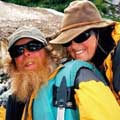We attended an excellent presentation given by Steve Bethune, Wildlife Biologist with ADFG on the Field Research Project here. The Field portion of the 5 year Bear Research project has been completed, and now they will be analyzing the results. The project was instituted to better understand and manage the bears on the Island. POW experienced an increase in bear hunting after a lot of great publicity in various outdoor publications . With the increased pressure there was a decline in numbers and the size of bears in areas that had easier accessibility. The numbers of hunters peaked a couple years before the drawing system was instituted, and had a spike on the last season before the drawing. The majority of Bear Hunting is done by non residents, it appeared to be about 80%. We don't harvest bears ourselves, but utilize the bear meat from our guests that donate to us for our subsistence needs. Some of these numbers may not be exact due to my memory and interpretation of the graphs Steve presented. The drawing resulted in 200 less bears being harvested per year, and appears to be having a positive impact on the numbers of bears. (it has only been 2 seasons so far since the drawing started, so it will take more time to make a valid evaluation) The average age of females is 5 to 6 years before giving birth to an average of 1.9 cubs. The study involved collaring and tagging approx. 50 bears in the great circle area. (Thorne Bay, Control Lake, Naukati, Coffman Cove, Beach Road circle along with data from the Honker Divide) The collared bears had both VHF and GPS collars. Hair, blood, tooth and weight was some of the data gathered along with location and tracking data. Steve had a rather ingenious bucket snare setup for capturing the bears without endangering other wildlife or the bears. The buckets were placed off the ground between 2 trees so that the bear had to reach inside the hole in the bucket to trip the snare. A radio signal was set off when the snare tripped. Trail cameras were also used and there was some incredible footage. He also showed some of the trophy shots taken of the captured bears, there are some great quality bears here. The bears were checked on when they entered the den during hibernation. They crawled inside of the den to take additional samples and evaluation. The bears were tranquilized with either a jab stick or CO2 gun, the cubs in the den were not tranquilized. One den had a 2 year old cub in it with the sow and didn't exhibit any signs of aggression and just watched while Steve worked. All of the dens were in in root wads and trees, and had nest matter brought in. There was no odor that they could smell in the dens. Some of the bears utilized up to 4 different dens during hibernation, and some would periodically take a short walk. The dens were distributed between sea level to 2400 ft. The hibernation period seems to be based on time or length of light, rather than temperature or snow. The sows entered hibernation first and emerged last. There were two other studies going on at the same time, Deer and Wolves. One interesting fact from the studies was that bears ate 39% of the deer during there first year while wolves ate only 2%, it is probably due to the number of bears versus wolves. There was no solid data on population numbers but a guesstimate of 4,000 to 5,000 bears. These are only the highlights that I remember from a couple hours of information. The good news is that Prince of Wales will continue to offer a quality hunting and viewing experience, and it should only get better in the future.
Gary
The Outdoor Line
EXPERT DRIVEN Hunting & Fishing Talk Radio - 710 AM
Prince of Wales Bear Research Project
1 post
• Page 1 of 1
-

onwhiskeycreek - Pollywog
- Posts: 76
- Joined: Mon Feb 24, 2014 12:09 am
- Location: Hollis Alaska
1 post
• Page 1 of 1
Who is online
Users browsing this forum: No registered users and 12 guests
